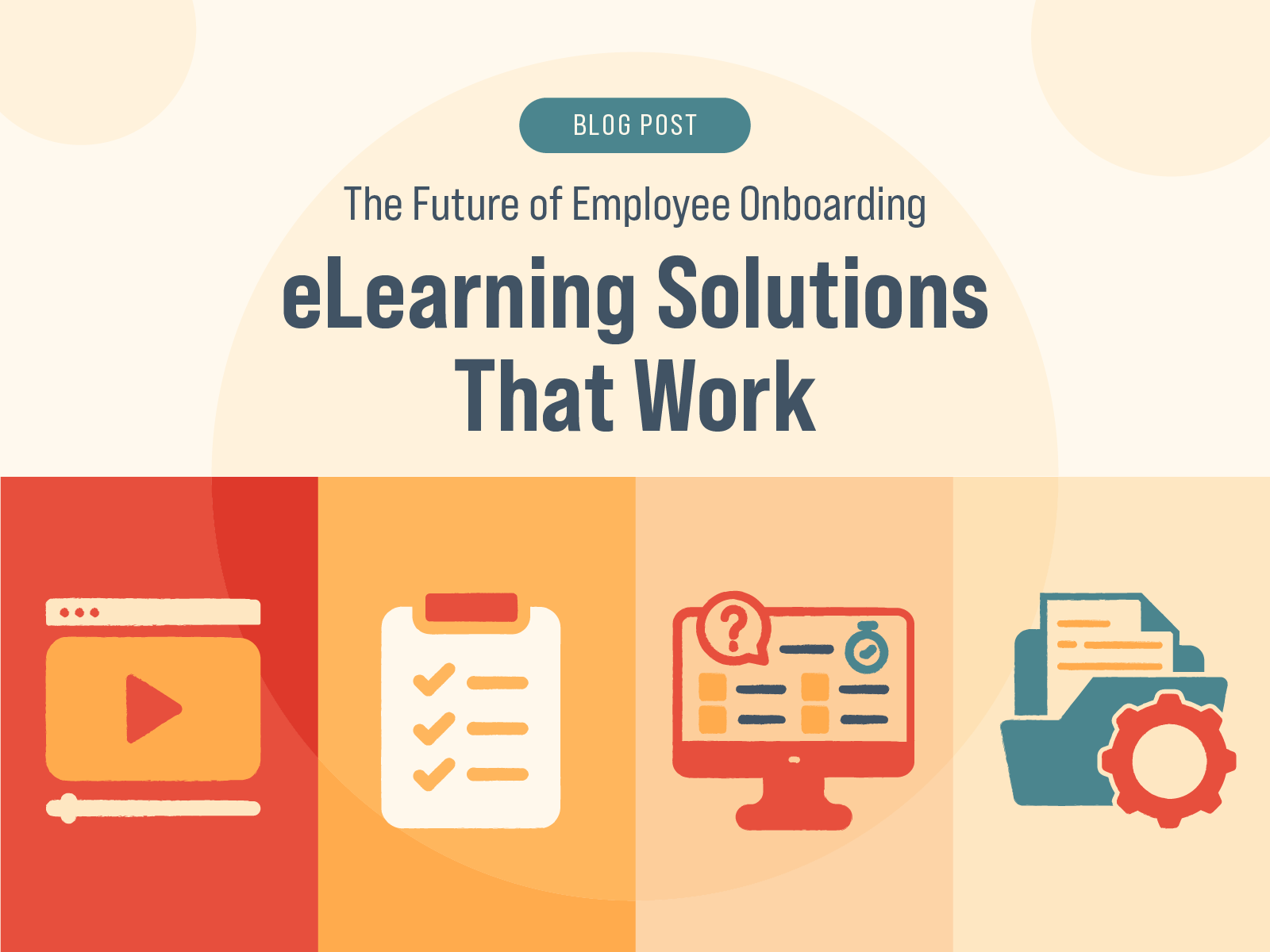Best Practices for Remote Employees Onboarding with eLearning
The pandemic forced millions of people across the globe to shift into a remote work environment. As organizations continue to embrace a more hybrid work model, it forces them to establish a smooth onboarding process that doesn’t consist of face-to-face interactions.
Establishing a smooth remote onboarding process can make a huge impact on how your employees integrate into your organization.
What Is Remote Employee Onboarding?
The process for onboarding remote employees consists of a series of steps and processes to welcome new team members and set them up for success in a new work environment. It’s also a great way for new employees to get to know their team members and learn about the culture, core values, rituals, and tools in their new workplace.
The process typically consists of both formal and informal onboarding processes. For example, the formal onboarding process typically consists of compliance classes, training sessions, and other formalized workshops to help learn the technical tools and guidelines. Informal onboarding may consist of ad-hoc meetings with higher-ups or shadowing other team members to learn the ropes of the business.
Remote onboarding must accomplish all of the above without any face-to-face interaction, making it that much more difficult for both employees and employers in this new remote working world.
Benefits of Remote Onboarding

Despite its challenges and nuances, there are many benefits of the onboarding process for remote employees. It covers the same topics as in-person onboarding yet it requires a structured approach to ensure it is executed correctly. If the process is done seamlessly, it can set your team up for long-term success.
Here are only some of the benefits of remote onboarding:
In-depth training: New employees won’t feel the pressure to learn everything on their own. They can take advantage of in-depth remote training that will set them up for future success.
- Connect new employees with their team: Did you know that with the right processes and tools, you can increase the sense of belonging in new hires by 70%? This is an easy way to start them off on the right foot in your organization!
- Increase new hire engagement: Instill a sense of excitement in your new hires by providing them with clear expectations and engaging training. The more structured your remote onboarding process, the more productive your team will be.
Why Use eLearning for Onboarding?
eLearning for onboarding comes with many benefits that your company can consider:
- It helps to standardize the onboarding process and make it more repeatable for future new hires.
- There is likely a one-time production cost, but after that, the onboarding process is likely scalable and repeatable.
- Downtime and disruptions are minimized as the onboarding process can be completed from anywhere at any time.
- Tap into analytics and reporting to make sure the training is effective.
- Blendable with in-person interactions such as handshakes or an office tour if your employees are located near your office.
Challenges of Onboarding Remote Workers
It’s not always easy to implement an enjoyable, effective remote onboarding process. Remote onboarding requires additional documentation to ensure effectiveness compared with traditional in-person onboarding programs. This is due to the fact that there is less opportunity to make on-the-fly adjustments to the onboarding process.
Building an emotional connection is a bit more difficult through a screen as well, and your new team members could feel isolated if they don’t have the necessary touchpoints to help them feel included.
Here are some common challenges of onboarding remote workers vs. the traditional onboarding process.
To some organizations, onboarding is a necessary evil, but when it comes to onboarding remote employees, it’s important that it’s executed properly.
How Long Should Remote Onboarding Take?
So, how long should onboarding for remote employees take? In-office onboarding processes typically last anywhere from one week to a few months depending on the industry and business specifics. Many factors are in play that help determine how long it takes—some businesses have an established framework that only requires two weeks while others lean on processes that consist of months-long onboarding.
The first step is establishing the goals of your company. From there, you’ll be able to create an onboarding process that makes sense for you. Generally speaking, however, you can assume that the remote onboarding process will take a bit longer than an in-person onboarding process.
How to Implement an eLearning-Based Onboarding System
If you’re ready to move forward with a remote onboarding process, you’ll want to explore the benefits of implementing an eLearning-based onboarding system. Here are some tips for onboarding remote employees.
Set Clear Goals
Having clearly defined goals with a host of details is pivotal in the remote onboarding process. Because there isn’t a physical office space, it could take your remote employees some time before they feel comfortable asking questions via chat and messenger.
You can also use a custom eLearning course to help with your employee onboarding process and assist new hires in reaching their goals. Set relevant milestones, review job-specific duties with the appropriate manager, and create interactive checklists to assist in material familiarization.
Develop a Clear Plan
Robust planning before your new hire begins can help set them up for a smooth onboarding process. Make sure to schedule any necessary meetings during the first few weeks on the job to reduce stress for both you and your new hire.
Planning ahead of time also reduces anxiety for the employee and ensures they are properly introduced to the right people, tools, and projects that will make up their daily work. Make sure to set a clear timeline to complete each milestone to keep the process on track.

Digitize HR Paperwork
Another best practice for onboarding new employees is to digitize any HR paperwork that needs to be filled out. Instead of mailing the paperwork to your new hires, consider digitizing contracts, tax documents, offer letters, handbooks, vacation policies, company organization charts, and other essential information.
Make sure to invest in software that keeps all of this information confidential.
Set Up a Remote Workspace
In the case of a remote employee who has a question about their equipment, they don’t have the luxury of walking over to a desk and asking for help. Instead, invest in an eLearning course that can help them set up their equipment through step-by-step instructions. These courses give your remote team to set up their equipment at their own pace.
List General Processes
You can also consider putting together an eLearning course that outlines your company’s mission, values, and operational processes that currently exist. Consider outlining job roles, the organizational structure, day-to-day tasks, essential meetings, company events, benefits, etc. during the onboarding process. Revise this content as processes evolve.
Build Culture Intentionally
Establishing a strong culture is more difficult in a remote environment, but the right eLearning course can compensate for this. Adding social aspects to these courses can foster personal connections. For example, consider sharing corporate video of current employees speaking on their experience or film a tour of the physical office so remote employees can see what it looks like.
Check-In Regularly
Check-in often to make sure new remote employees have the outlets necessary to ask questions and feel more comfortable with their role in the company. If the onboarding process is long, checking in with them multiple times is a great way to foster an open line of communication.
Remote Work Is Here to Stay, Start Preparing!
With more and more companies offering remote work, make sure you’re investing in the tools that will set up your remote employees for long-term success. Allegro Media Design has over a decade of experience creating custom eLearning courses that can help your team transition into this new environment. Contact us to learn more about how we can assist your business!
More Articles


Gamification in eLearning: Why It Works and How to Implement It

The Future of Employee Onboarding: eLearning Solutions That Work

What is SCORM and What Does it Matter

Accessibility in eLearning: Why It’s Essential and How to Achieve It

Microlearning: Bite-Sized Training for Big Results

Soft Skills Training Through eLearning: Building Better Leaders

How to Write Learning Objectives for eLearning Courses

When to Outsource Your eLearning Development (and How to Choose the Right Partner)

Employee Engagement in 2025: How eLearning Can Help

Training for a Multigenerational Workforce: Meeting Everyone’s Needs

The Future of eLearning: 4 Trends Shaping the Industry

How To Find the Right eLearning Developer

What Makes eLearning Effective?

Transform Your eLearning with the Magic of Animation

How to Use Audio to Enhance eLearning

Boost Learning Efficiency with Microlearning

Give Your Dated eLearning a Fresh Facelift

The Process of eLearning Part 5: The Implementation Phase

The Process of eLearning Part 4: The Development Phase

The Process of eLearning Part 3: The Design Phase

The Process of eLearning Part 2: The Analysis Phase

The Process of eLearning Part 1

Empower Your Workforce with Self-Paced Training

Elevate Your Training with Exceptional Visual Design

Taking the Confusion Out of SCORM

Embrace Efficiency: The Power of Outsourcing Your eLearning Production

Mastering eLearning: Elevating Corporate Training Through Scenario-Based Learning

Converting ILT to vILT: Embrace the Virtual Shift

Spice Up Your Boring Corporate Training With Animated Videos Copy

From Concept to Clicks: The Crucial Role of eLearning Developers

Lost in Translation: Mastering Multilingual eLearning

Training Crossroads: ILT or eLearning – What's Your Strategy?

How to Transform Boring Compliance Training

Last-Minute Crunch? Allegro Media Delivers Rapid eLearning Solutions Just-In-Time!

The Art of Chunking (or How to Eat a Whale)

Zen & The Art of eLearning Maintenance: Finding Harmony with Allegro Media Design

How to leverage ChatGPT for eLearning Applications

What Should I Look for When Hiring an eLearning Vendor?

Unveiling the Future of eLearning: Trends to Watch in 2024

Subject Matter Experts: Be Proud! Allegro loves you just how you are!

What in the World is an LMS?

Enhancing eLearning Engagement: The Power of Scenario-Based Interaction with Stylized 3D Motion Images

Enhancing eLearning with DALL-e: Adding Visual Reinforcement for Engaging Corporate Training

Choosing the Right Authoring Tool for Your eLearning Course

High Quality Audio is ESSENTIAL in Modern eLearning

What in the World is SCORM?

A Complete Guide to Leadership Training and Development

Benefits of Customer Service eLearning Training

14 Tips To Effectively Use Audio for eLearning Courses

10 Instructional Design Tips for Effective eLearning

Why You Should Use eLearning For Product Training

Benefits of Voice Overs for Your Business

How to Create Great eLearning Content: 9 Tips

Video Marketing for Business: 10 Benefits of Promotional Videos

Gamification in the Workplace: Why and How to Use It

5 Best Practices for Training Remote Employees

How to Avoid eLearning Burnout and Fatigue

What Is Customer eLearning Training and Why Do You Need it?

8 eLearning Sales Training Best Practices: Tips & Use Cases

How to Effectively Use Videos in eLearning

Why You Should Invest in Corporate eLearning?

How Can eLearning Reduce Employee Burnout?

How to Motivate Employees to Participate in eLearning Training: 9 Tips

eLearning Trends and Predictions: 2022 Forecast

7 Reasons to Outsource Your eLearning Course Development
%20to%20Virtual%20Instructor-Led%20Training%20(VILT).jpg)
How to Convert Instructor-Led Training (ILT) to Virtual Instructor-Led Training (VILT)

12 Best Tips on How to Improve Employee Training with Gamification in 2021-2022

What Is Compliance Training and Why Is It Important for Your Business?
%20vs.%20eLearning.jpg)
Instructor-Led Training (ILT) vs. eLearning: Which Should I Choose?

The Difference Between An Instructional Designer And An eLearning Developer
















